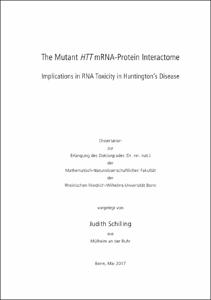Schilling, Judith: The Mutant HTT mRNA-Protein Interactome : Implications in RNA Toxicity in Huntington’s Disease. - Bonn, 2017. - Dissertation, Rheinische Friedrich-Wilhelms-Universität Bonn.
Online-Ausgabe in bonndoc: https://nbn-resolving.org/urn:nbn:de:hbz:5n-48859
Online-Ausgabe in bonndoc: https://nbn-resolving.org/urn:nbn:de:hbz:5n-48859
@phdthesis{handle:20.500.11811/7289,
urn: https://nbn-resolving.org/urn:nbn:de:hbz:5n-48859,
author = {{Judith Schilling}},
title = {The Mutant HTT mRNA-Protein Interactome : Implications in RNA Toxicity in Huntington’s Disease},
school = {Rheinische Friedrich-Wilhelms-Universität Bonn},
year = 2017,
month = nov,
note = {Huntington’s disease (HD) is an autosomal dominant neurodegenerative disorder that is characterized by progressive motor, cognitive, and psychiatric symptoms. The mutant gene product contains an elongated stretch of CAG repeats that translates into an extended sequence of polyglutamines within the Huntingtin (HTT) protein. Many of the pathologic cellular mechanisms underlying HD are based on aberrant protein interactions of mutant HTT. Amongst others, affected processes include transcription, energy metabolism, axonal transport, synaptic transmission, and the proteostasis network. Additionally, mutant HTT RNA impacts cellular functions as well. A toxic gain-of-function of the mutant CAG repeat RNA can be explained by the sequestration of various RNA binding proteins, leading to deregulation of cellular mechanisms like RNA interference, alternative splicing, and gene expression. One specific example is the MID1 complex that enhances translation of mutant HTT exon 1 RNA, thereby increasing the production of toxic protein species.
This study shows that MID1 specifically regulates the translation of structured RNAs, revealing a requirement for the mechanism of MID1-dependent translation. Furthermore, MID1’s close association with the translation initiation complex is confirmed. The identification of new and the verification of known binding partners locates MID1 within a large complex comprising eukaryotic initiation factors and ribosomal proteins. Together with the known CAG length-dependent binding of MID1 to HTT exon 1 RNA, this suggests that MID1 is an important factor directing the translational machinery to mutant CAG repeat RNAs, thereby possibly acting as a disease modifier. Moreover, in HD patients, MID1 expression is upregulated, corroborating this hypothesis.
The comparison of MID1 protein interactions with HTT exon 1 binding partners shows substantial overlap. 25% of the identified proteins are shared binding partners. Interestingly, gene ontology analysis of the HTT exon 1 interactome shows that 43% of the proteins can be assigned to the process of splicing and 53% of these preferentially bind to mutant HTT exon 1 RNA. Therefore, the analysis of splicing changes in a cellular model of inducible mutant HTT exon 1 RNA expression was conducted. Specific splicing events were identified that can be attributed to HTT exon 1 protein binding partners and this was confirmed in HD patient brain samples.
Together, this study extends the knowledge of MID1-dependent mechanisms of translation, characterizes the HTT RNA-protein network and identifies aberrant downstream effects that might contribute to HD pathogenesis.},
url = {https://hdl.handle.net/20.500.11811/7289}
}
urn: https://nbn-resolving.org/urn:nbn:de:hbz:5n-48859,
author = {{Judith Schilling}},
title = {The Mutant HTT mRNA-Protein Interactome : Implications in RNA Toxicity in Huntington’s Disease},
school = {Rheinische Friedrich-Wilhelms-Universität Bonn},
year = 2017,
month = nov,
note = {Huntington’s disease (HD) is an autosomal dominant neurodegenerative disorder that is characterized by progressive motor, cognitive, and psychiatric symptoms. The mutant gene product contains an elongated stretch of CAG repeats that translates into an extended sequence of polyglutamines within the Huntingtin (HTT) protein. Many of the pathologic cellular mechanisms underlying HD are based on aberrant protein interactions of mutant HTT. Amongst others, affected processes include transcription, energy metabolism, axonal transport, synaptic transmission, and the proteostasis network. Additionally, mutant HTT RNA impacts cellular functions as well. A toxic gain-of-function of the mutant CAG repeat RNA can be explained by the sequestration of various RNA binding proteins, leading to deregulation of cellular mechanisms like RNA interference, alternative splicing, and gene expression. One specific example is the MID1 complex that enhances translation of mutant HTT exon 1 RNA, thereby increasing the production of toxic protein species.
This study shows that MID1 specifically regulates the translation of structured RNAs, revealing a requirement for the mechanism of MID1-dependent translation. Furthermore, MID1’s close association with the translation initiation complex is confirmed. The identification of new and the verification of known binding partners locates MID1 within a large complex comprising eukaryotic initiation factors and ribosomal proteins. Together with the known CAG length-dependent binding of MID1 to HTT exon 1 RNA, this suggests that MID1 is an important factor directing the translational machinery to mutant CAG repeat RNAs, thereby possibly acting as a disease modifier. Moreover, in HD patients, MID1 expression is upregulated, corroborating this hypothesis.
The comparison of MID1 protein interactions with HTT exon 1 binding partners shows substantial overlap. 25% of the identified proteins are shared binding partners. Interestingly, gene ontology analysis of the HTT exon 1 interactome shows that 43% of the proteins can be assigned to the process of splicing and 53% of these preferentially bind to mutant HTT exon 1 RNA. Therefore, the analysis of splicing changes in a cellular model of inducible mutant HTT exon 1 RNA expression was conducted. Specific splicing events were identified that can be attributed to HTT exon 1 protein binding partners and this was confirmed in HD patient brain samples.
Together, this study extends the knowledge of MID1-dependent mechanisms of translation, characterizes the HTT RNA-protein network and identifies aberrant downstream effects that might contribute to HD pathogenesis.},
url = {https://hdl.handle.net/20.500.11811/7289}
}






